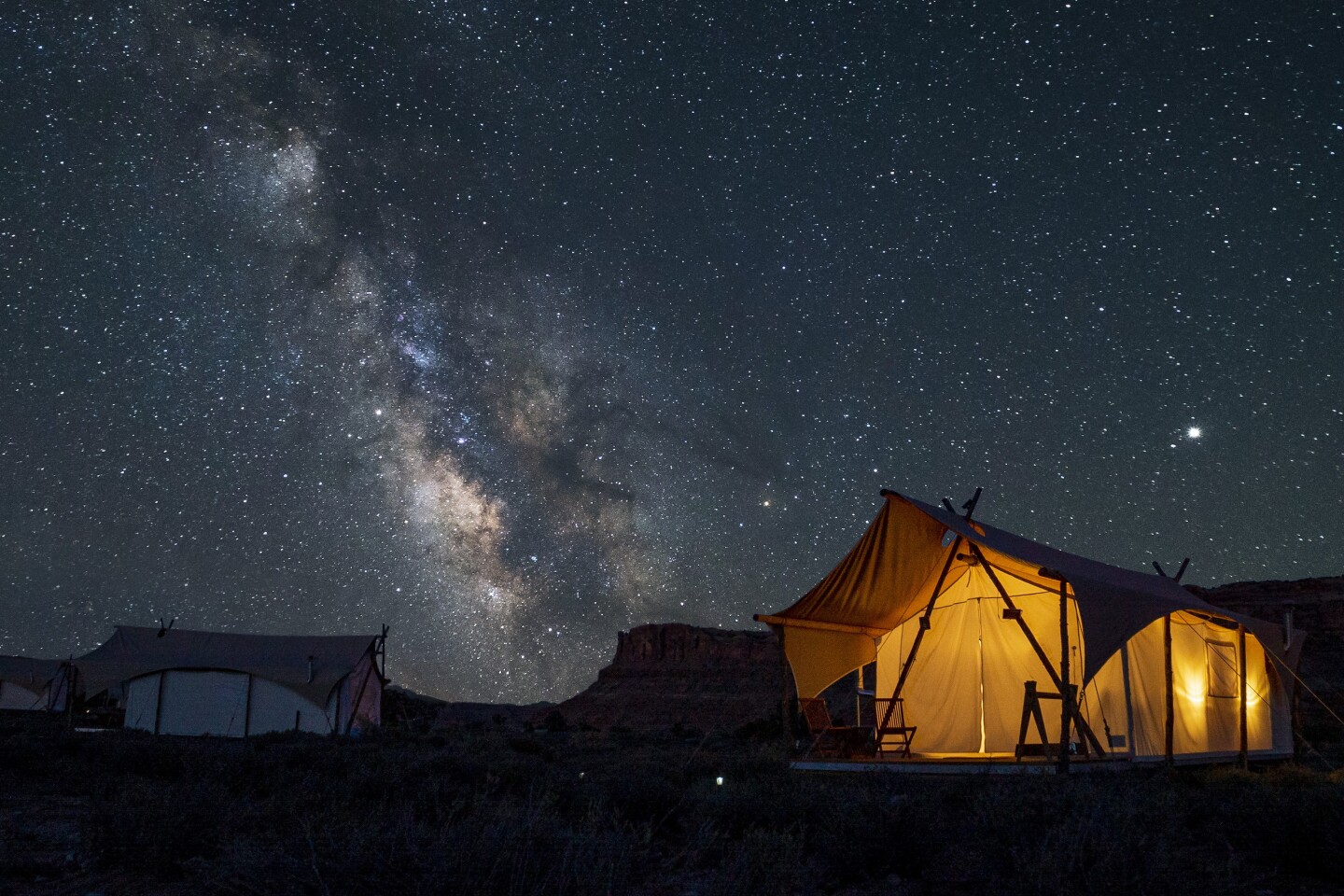Utah just added another notch in its glorious belt of red desert landscapes, storied rock arches with petroglyphs, and deep-reaching canyons. On top of the state’s Mighty Five national parks—Arches, Bryce Canyon, Canyonlands, Capitol Reef, and Zion—there’s another reason to visit Utah: Its dark skies.
The city of Moab was deemed an International Dark Sky Community on June 6. That makes 26 certified International Dark Sky Places in Utah―the highest concentration in the world.
While urban light is increasing by 10 percent each year, the global nonprofit DarkSky has been countering light pollution by working with communities, parks, and municipalities to modify and eliminate lighting sources to save energy and enhance darkness since 2001. After astronomers realized in 1970 that street lamps and neon signs were interrupting the light rhythm that’s vital to the natural migration, reproduction, and growth of wildlife, more than 200 DarkSky-certified places have been designated in 22 countries. As a result, a thriving astrotourism movement is attracting interest in reduced light pollution that allows for better stargazing and―with increasing solar activity―viewing of the northern lights, particularly in Utah, home to some of the darkest skies in North America.
Moab was a natural choice for Utah’s DarkSky destinations after the city’s first ordinance to dim the lights in 2019, which reduced glare and illumination and ensured that outdoor lighting fixtures were shielded. Rich in natural diversity, the city’s surrounding area, known as Canyon Country, is a gateway to wild landscapes filled with red rock, boulders, and hoodoos, perfectly suited for stargazers. “Pursuing the designation helped us evaluate our outdoor lighting to improve safety and energy efficiency while minimizing light we waste in places we don’t want it, like the sky,” says Alexi Lamm, sustainability director for the city of Moab.
With astrotourism on the rise and the northern lights on the brink of another big show as we near solar maximum, with increased activity in their 11-year cycle, now is the time to plan a trip. Celebrate Moab’s new International Dark Sky Community designation by stopping by these heavenly spots for beautiful views of the twinkling night sky.
Moab and the Southeast
Providing easy access to five Utah national parks—and nestled between two of them, Arches and Canyonlands—is the city of Moab, population 5,321. Walk through the natural arches and red-rock formations dating back millions of years to the dinosaurs; you can have a spectacular view of the formations from any direction, but they serve especially well as a backdrop to the Milky Way. A visit wouldn’t be complete without driving a short way to the dedicated stargazing area of Panorama Point at Arches National Park (open 24 hours a day, seven days a week), to the high plateau and celestial wonders of Dead Horse Point State Park, and to the world’s largest natural stone bridges at the first-ever International Dark Sky Park, Natural Bridges National Monument.
Where to stay: Stay at Gravity Haus Moab, the latest tech-forward boutique hotel designed for active travelers. Located in downtown Moab and featuring an outdoor pool and jacuzzi and views of the surrounding red rocks, the hotel has partnered with local tour operators to offer sand-dune tours, mountain biking, climbing, and hiking adventures for those who want an adrenaline-fueled immersion in the surrounding beauty before the stars come out at night.

Book a tricked out tent with Under Canvas Moab for easy access to the stars.
Photo by Bailey Made/Under Canvas
Bryce, Zion, and the Southwest
Driving west, work your way up in elevation to Bryce Canyon National Park, an International Dark Sky Destination since 2019, with a calendar full of dark-sky programming, including an astronomy festival. Take in thousands of stars from this high-up remote vantage point, looking across the Grand Staircase from Sunrise or Inspiration points on a clear night, where you’ll also see nearly 200 miles to the Black Mesas of eastern Arizona. And for night hikes in some of the darkest skies in the contiguous United States, head to Zion, hugging the darkest section on the eastern edge of the park along Kolob Terrace Road. While you’re in the area, check out other DarkSky-certifited spots, including Cedar Breaks National Monument, where stargazing parties are thrown 10,000 feet above sea level.
Where to stay: Connect with nature and the night sky by glamping under the stars in a canvas tent at ULUM Moab or at the first DarkSky-certified resort Under Canvas, with locations in Moab, Zion, or Bryce Canyon. Come August 1, astrotourists will be able to book into Clear Sky Resorts’ new glass dome resort in an 80-acre canyon 15 minutes outside of Bryce Canyon National Park, featuring 62 luxury domes with floor-to-ceiling geodesic windows that offer views of the surrounding landscape and the cosmos above.
Northern Utah
Minutes from Snowbasin and Powder Mountain, you can ski or, during the warmer months, hike, bike, paddle, or horseback ride in another of Utah’s certified International Dark Sky Park known as North Fork. Here in the Wasatch Range, about a four-hour drive north of Moab, visit the Astronomic and Lunar Observatory for planetary views. Prefer stargazing from a chairlift? Take a summer moonlight lift ride to the top of Sundance Mountain Resort, just south of three certified Dark Sky Parks: Timpanogos Cave, Jordanelle State Park, and Rockport State Park.
Where to stay: Curl up in a cabin at Sundance Mountain Resort, a ski area purchased by Robert Redford in 1969, the year Butch Cassidy and the Sundance Kid was released. Downstairs from the Huntsville observatory, you can find a boutique stay at Compass Rose Lodge, owned by Bonnie and Jeff Hyde, a former competitive freestyle skier. Don’t leave without stopping by “the oldest bar in Utah,” the 1850 Shooting Star Saloon, right across the street.








